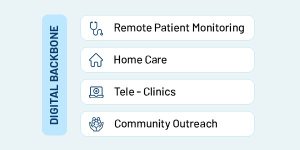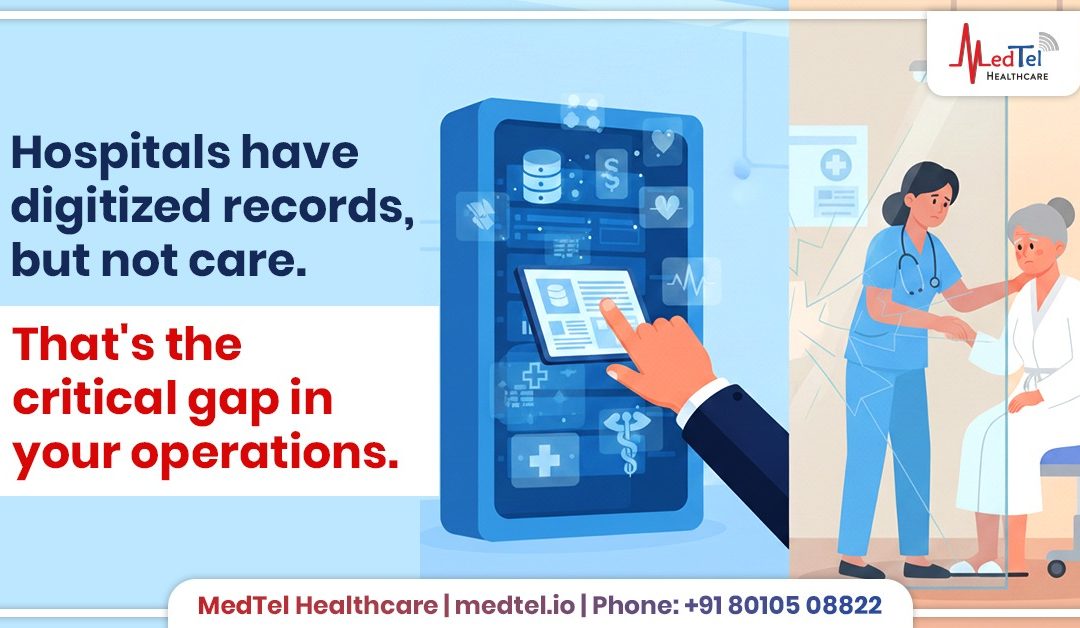Hospital leaders are trapped in a cycle: buying new, disconnected apps to solve urgent care-delivery problems, only to create more operational fragmentation. While our EMRs have digitized records, our care itself remains a patchwork of siloed data, manual processes, and high-risk gaps.
This fragmentation isn’t just an IT headache; it’s an operational failure. It leads directly to missed patient escalations, inefficient workflows, and a disjointed experience for both patients and clinical staff.
The solution isn’t another niche app. The next leap for hospital efficiency is a platform-first upgrade.
The Thesis: A “Digital Backbone” for Care
The upgrade hospitals need is a single, interoperable “digital backbone.” This is a core data layer designed to accept, process, and analyze inputs from every source:
- Device Inputs: Data from IoMT devices for remote monitoring.
- Human Inputs: Observations from clinical staff, home-care nurses, and patients.
- Process Inputs: ADT (Admission, Discharge, Transfer) information and schedules from the HIS/EMR.
Once this data backbone is in place, it can expose a suite of modular services that all speak the same language. This allows a hospital to deploy, manage, and scale all its digital health initiatives from one central system, including:

- Remote Patient Monitoring (RPM): For chronic disease management and post-discharge follow-up.
- Digital Home Care: To manage nurse-led programs and high-quality elder care.
- Tele-Clinics: To expand your catchment area, triage patients, and feed specialty clinics.
- Community Outreach: For high-volume digital screening camps.
From Data Flow to Leadership View
Operationally, the architecture is built for simplicity and scale. It follows a clear data flow: Ingest (collecting multi-source data) $\rightarrow$ Rules (applying clinical logic and alerts) $\rightarrow$ Dashboard (visualizing for clinicians) $\rightarrow$ API (sharing relevant data back to the EMR/HIS).
This model, proven resilient in large-scale public-health deployments, ensures that all data—whether from a home-care visit or a remote vital-sign reading—is processed through the same secure, auditable system.
For hospital leadership, this approach solves two of the biggest challenges in digital transformation:
A Single SLA: Instead of managing dozens of vendor contracts, security protocols, and integration points, the organization manages one platform. This simplifies governance, security, and vendor management for the CIO.
Consolidated Analytics: For the first time, leaders can see a unified, real-time view of all digital care initiatives. You can measure clinical outcomes, operational efficiency, and ROI across RPM, home care, and outreach on a single dashboard, enabling true data-driven decisions for the CEO and COO.
Your Roadmap to Digital Continuity
The era of piecemeal digital solutions is creating more complexity than value. The future of hospital operations lies in a unified digital backbone—one platform that connects all facets of care delivery, inside and outside the hospital walls.
See the Digital Backbone in Action
Ready to move beyond fragmented systems? Schedule a live demo to see how a unified digital backbone can consolidate your analytics, simplify operations, and power your hospital’s digital upgrade.
